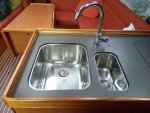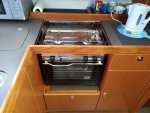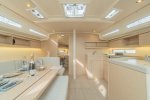Mrstarskydean
Member
Went to the Southampton Boat Show and had a wonderful time. At some point we plan to sell the house and set off. We shall see. As boat owners in our modest 28ft/40 year old sailing yacht way we have made our first steps. So it was not a total fantasy for the wife & I to play 'if you had to have one, which sailing boat would it be?'
Perhaps I am a bit naive but I expected show staff to actually know their product - I don't mean specs to last detail, but just if the model in question is a sailing boat or not!
The prices made sense, new sailing yachts are never cheap. Ok I get that. But the real shocker was when I looked around inside. Some of the interiors were well thought-out and provided great choice. But at home we have a seventeen year old IKEA kitchen that is in better nick than these brand new yachts at £250k-£350k. I'm not talking about show-soiled boats, I mean the original quality of the materials.
Then I check out the CE ratings. Again I am (if you have not already guessed) no expert, but frankly I expected more. Category A CE seems to have somewhat modest requirements as a top slot - big expensive brand new sailing yachts. Just looking at the hull shapes (why does no one seem to talk about that any more?) does not inspire confidence. Perhaps this something I already know in my heart - after all there was only one boat at the show (made in Falmouth....) that I'd want to cross oceans in.
OK many modest yachts have crossed oceans, but I expected CE A rated £££££ 40ft+ yachts from big makers, to be better than they are. Are my expectations all wrong? As it stands new boats are off the shopping list.
Perhaps I am a bit naive but I expected show staff to actually know their product - I don't mean specs to last detail, but just if the model in question is a sailing boat or not!
The prices made sense, new sailing yachts are never cheap. Ok I get that. But the real shocker was when I looked around inside. Some of the interiors were well thought-out and provided great choice. But at home we have a seventeen year old IKEA kitchen that is in better nick than these brand new yachts at £250k-£350k. I'm not talking about show-soiled boats, I mean the original quality of the materials.
Then I check out the CE ratings. Again I am (if you have not already guessed) no expert, but frankly I expected more. Category A CE seems to have somewhat modest requirements as a top slot - big expensive brand new sailing yachts. Just looking at the hull shapes (why does no one seem to talk about that any more?) does not inspire confidence. Perhaps this something I already know in my heart - after all there was only one boat at the show (made in Falmouth....) that I'd want to cross oceans in.
OK many modest yachts have crossed oceans, but I expected CE A rated £££££ 40ft+ yachts from big makers, to be better than they are. Are my expectations all wrong? As it stands new boats are off the shopping list.



